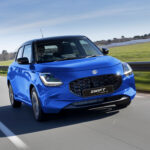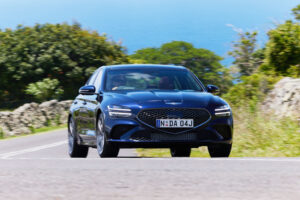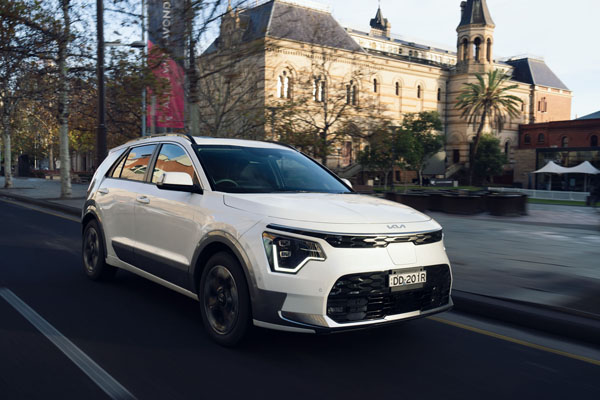
The all-new Kia Niro is a small SUV that’s available in two efficient FWD electrified
powertrains, the Hybrid Electric (HEV) and full Electric (EV).
It features a strong influence from the 2019 HabaNiro concept car. It has the latest
evolution of Kia’s signature Tiger Face grille which extends from the bonnet to the bumper.
A bold skid plate and cladding enhance the car’s rugged character.
The second-generation Niro offers a choice of eight exterior colours across the range
including Cityscape Green which is new to Kia’s colour pallet, Snow White Pearl, Aurora
Black Pearl, Mineral Blue, Interstellar Grey, Runway Red, Steel Grey and Clear White.
Most have gloss black lower cladding, but the EV GT-Line has Snow White Pearl.
For the first time, the Kia Niro range provides options for personalisation with a choice of
contrasting C-Pillar colours in the GT-Line trims; Cityscape Green and Mineral Blue can be
combined with a gloss black C-Pillar (HEV and EV GT-Line), while the EV GT-Line in
Snow White Pearl can be paired with a C-Pillar and cladding in Steel Grey.
Premium and eco-friendly materials create a minimalist contemporary feel while modern
digital displays and interior controls, have been optimally placed to further enhance the
user-friendly operating experience.
The entry HEV S comes with a 4.2-inch multi-function LCD cluster. A digital display
replaces analogue gauges.
The EV S trim incorporates the 10.25-inch digital cluster with an 8.0-inch AV touchscreen.
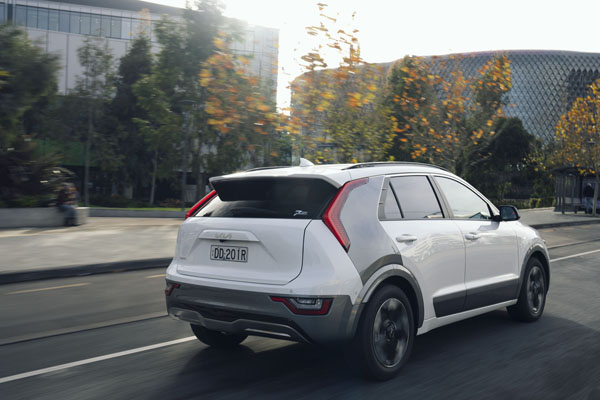
The GT-Line trim in both HEV and EV variants provides a panoramic high-definition digital
display screen that integrates both the instrument cluster (10.25-inch) and infotainment
features (10.25-inch) in one package.
Located below the centre screen is an integrated touch sensitive infotainment and climate
control system that lets the front seat occupants access these i controls without the need
to scroll through multiple menus.
The driver can operate the Kia Niro’s electronic dial-type shift lever (HEV GT-Line & EV
S/GT-Line), the design of which saves space and is convenient and intuitive to operate. A
wireless Qi charging pad (GT-Line) is close to hand.
The front passenger premium relaxation seat in the EV GT-Line can recline at the touch of
a button while parked or charging to enable the passenger to relax in supreme comfort.
Across the range is USBC charging.
The all-new Niro’s dimensions have grown over its predecessor, with a length measuring
4420mm, a width of 1825mm, a height of 1545mm HEV/1570mm EV, and a wheelbase of
2720mm (increased length 65mm HEV/45mm EV, width 20mm and wheelbase 20mm).
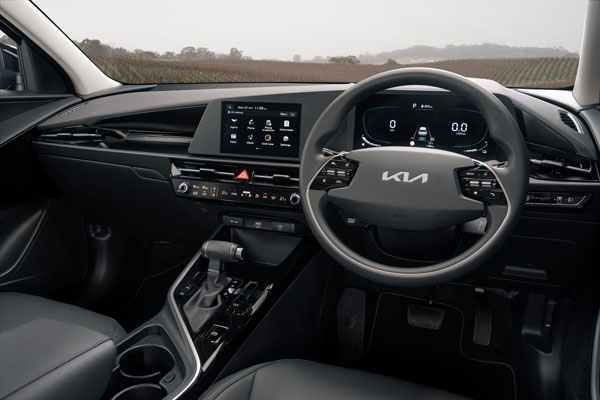
Kia’s commitment to sustainability has recycled materials inside the cabin. The headlining
is made from recycled PET materials, the seats are made from Bio PU with Tencel from
eucalyptus tree fibres.
The all-new Kia Niro is available with two efficient FWD electrified powertrains, Hybrid
Electric (HEV) and full Electric (EV).
The 1.6-litre four-cylinder petrol engine has improved cooling, friction and combustion
technologies. It produces a maximum output of 77.2kW along and 144 Nm of torque.
When combined with the 32kW permanent magnet synchronous electric motor, the HEV
model produces a combined maximum power output of 104kW and 265 Nm of torque.
The 1.6-litre GDI engine is mated to the second-generation six-speed dual-clutch
transmission.
The 64.8kWh electric option is paired with a Single Speed Transmission (reduction gear),
provides 150kW power and 255Nm of torque, and a single charge driving range of 460
kilometres.
The full electric Niro has as an official range of a 460km.
Topping up the EV’s 64.8kWh lithium-ion polymer battery from 10-80 per cent takes just 43
minutes with a suitable DC rapid charger.
The all-new Niro comes with a standard CCS2 charging port for added convenience. Kia
says, “AC and DC charging times for the all-new Niro have improved over the outgoing
model.” But doesn’t supply detail on this.
Kia’s smart regenerative braking system enables drivers to choose from a series of
regeneration levels to easily slow the car and recuperate kinetic energy to maximise the
driving range. The system can calculate the amount of regeneration required using radar
and road gradient information. The system allows the car to gain the maximum amount of
energy from its brakes.
The next-generation Niro EV gains in braked towing capacity which is now 750kg
(previously 300kg) The HEV maximum braked towing capacity remains at 1,300kg.
The all-new Kia Niro has undergone an extensive local ride and handling program to
ensure it is suitable for Australia’s unique road conditions and driving styles. This is also
Kia Australia’s first full ride & handling program since the start of the pandemic with the
opportunity to tune the MDPS (steering) map.
We are told that, “The result, is car like handling with nice and flat body control and
minimal roll coming into corners, providing driver confidence. A significant improvement
over the outgoing model and comparable to European benchmarks.”
We will borrow a test Kia Niro for our usual week road test review and give our thoughts
and opinions shortly afterwards.




